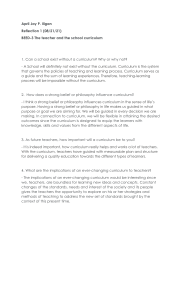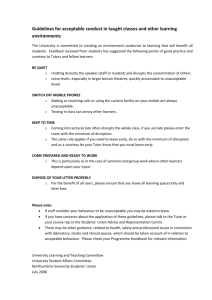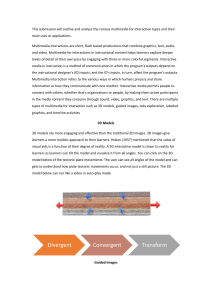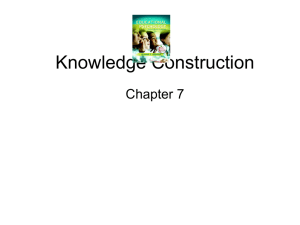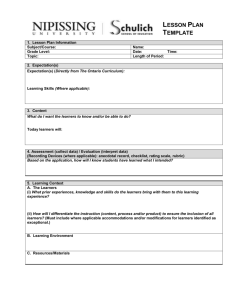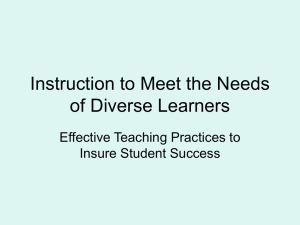Teaching Large Classes
advertisement
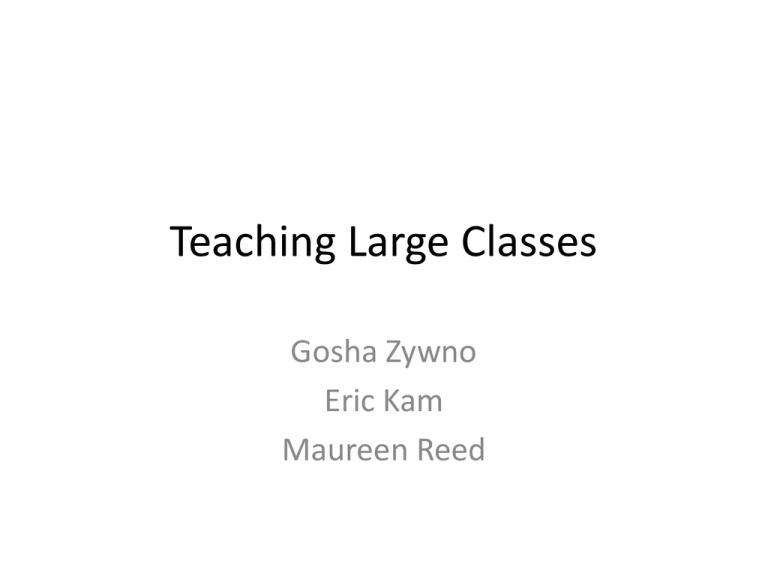
Teaching Large Classes Gosha Zywno Eric Kam Maureen Reed Large or Small? Relative to small classes engaging students requires: •More planning •More behaviour management •More effort to get to know the students •More performance skills •More emails, marking, ….more time management Effectively teaching large classes involves • • • • • Make your class feel small Being organized Managing Disruption Teaching to Diversity Personalizing the environment with active learning Make your large class feel small • Walk around, move towards students, group work, TAs hand things out • Encourage questions • Be available • Learn student names….if possible • Relate material to student experience, add your own • Give personalized feedback Being organized- The Lecture • • • • • Know the learning outcomes for your course Know your students level and experience Lecture needs to be added value to the text Teach less better Include stage directions in your notes-when will you do what • Have a plan B if technology fails • Plan when you will give activities and breaks During the Lecture • • • • • Provide an Agenda Know material so you do not need to read Provide occasional summaries Check that students can see and hear you Repeat questions Managing Behaviour • Consider the class contract • Plan for disruption • Solicit feedback – One minute paper – Create test items – Ask what they would like repeated Teach to Diversity • • • • • • Multiple ways of presenting the same concept Encourage natural supports Repeat questions Post slides or try guided notes Be engaged with your students A word about age Teaching Strategies for Younger Learners Characteristic Strategy Don’t always have life experience Bring in relevant stories, videos, and news items that they can discuss May not have well established values and beliefs (or may have unexamined beliefs) Show them the diversity of opinion on topics and kindly try to correct misconceptions Turn to the faculty member for guidance Try to show them what a self directed approach is but give clear guidance in assignments and activities Feel the need to be taught Provide them with content material Like a guided approach Provide guided activities that they can work on in class Are fine with survey courses but want some experience Show them how course materials apply to their life and future professions. Tell them about your research of professional experience Learn in many ways and need information presented in many ways Use a variety of teaching methods Teaching Strategies for Adult Learners Characteristic Strategy Have life experience Use their experience in class. Often have well established values and beliefs Permit debate and challenge ideas, but be firm in expectations Want to be treated as adults Acknowledge their opinions and comments and questions, be clear that they do not always have to agree with you Need self directed learning Engage students in designing the learning environment, suggest further resources, when appropriate give choices Like problem centered approaches Show how their new knowledge and skills can be applied Like courses with applied information Tie theory and concepts to applications Rochester Institute Technology (2013) http://online.rit.edu/faculty/teaching_strategies/adult_learners.cfm that they canof use immediately Learn in many ways Use a variety of teaching methods Large Class Techniques • The story • The token system for discussion • The class debate
